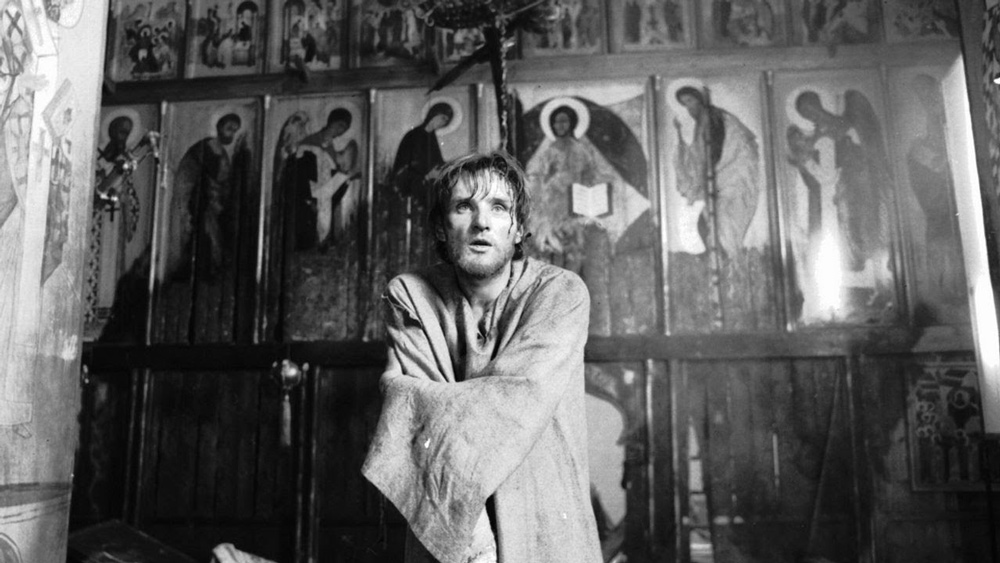

The most interesting movie this week came out fifty-five years ago.
A masterpiece of spiritual filmmaking that has been described as the War and Peace of Russian cinema, Andrei Rublev offers a series of vignettes drawn from the life of the medieval icon painter from which the film takes its name.
The historical Rublev is probably best known as the writer of the icon of the Trinity (in Orthodox tradition, icons are not painted but “written”) which is modelled upon the Old Testament story of the three supernatural visitors to Abraham and Sarah (related in Genesis 18). Rather like this icon, which adheres to the ancient custom of depicting God the Father only indirectly, so too this film is characterized by an obliquely conveyed sense of all-enveloping divinity.
It opens amidst the ruins of a flooded church. It then depicts Rublev as he encounters feudal patrons, profligate pagans, and holy fools. It concludes with an extended, slow pan survey of several of Rublev’s icons.
This may not sound like much of a story, and in a certain sense it isn’t (Rublev, who ties the project together, does not even appear in every vignette). It is nonetheless a powerfully suggestive piece of cinema.
It is so powerful, in fact, that it was initially forbidden to be shown. As a state-sponsored film in an officially atheistic Communist regime, Andrei Rublev came under the fire of Soviet era Gosinko censors and was banned after only one public screening.
Why this kind of reaction to a movie many modern viewers might consider a slow-moving, relatively uneventful art piece?
The answer almost certainly has to do with that final sequence of meditating upon icons, which Orthodox Christians regard as the visual analogue to verbal divine revelation in Sacred Scripture.
By concluding the film in this way, the director, Andrei Tarkovsky, seems to be deliberately inviting viewers into an experience of adoration — not, of course, worship of the images as mere images, but worship which passes to their prototype, in accordance with the distinction set forth by the Second Council of Nicaea.
The fact that the censors did not simply chop off this concluding sequence suggests that this ending is no mere extraneous add-on, but the fitting climax to what the film has been doing all along. Its series of vignettes, in other words, might themselves be considered not simply as loosely related episodes but as moving image icons, meditations upon a saintly life which has become luminous of the divine.
Regarded in this way, iconologically, the greatness of Andrei Rublev shines.
This perspective also appropriately situates its somewhat alien, almost plodding pacing. Like the sacred image of an icon which invites its viewers into a slower, weightier kind of consideration than profane images which are designed merely to be glimpsed and discarded, so too cinema like Andrei Rublev offers its audience a dramatic pedagogy in a sanctified way of seeing.
Like the weather-ruined icons we see in the opening sequence which by the film’s end are re-presented in pristine condition, the dramatic images of their human creator we watch in between offer images of a person on the road to holiness, an artwork being restored before our eyes.
Can we discern the splendour amidst the squalor of an imperfect human life? Are the traces of eternity still detectable amidst their repeated, sometimes even programmatic desecration and suppression?
In a certain sense, Andrei Rublev might not offer much by way of story. At the same time, perhaps in no other film is it so apparent how cinema might function not exclusively as the vehicle for narrative, but operate as a complex artistic medium which synthesizes diverse artistic modes.
In an appendix to War and Peace, Tolstoy remarks how the sprawling shape of the novel results from his deliberate subordination of artistic form to the vision the work exists to communicate. Likewise, in Andrei Rublev narrative becomes the servant of a more urgent purpose, its dramatic and chronological elements subordinated to the visual and spatial, which results in representation of its subject that edges upon timeless.
Such a marriage of form and function — an iconic depiction of a maker of icons — makes Andrei Rublev not only one of Russia’s great films, but, indeed, one of humanity’s great works of art.
